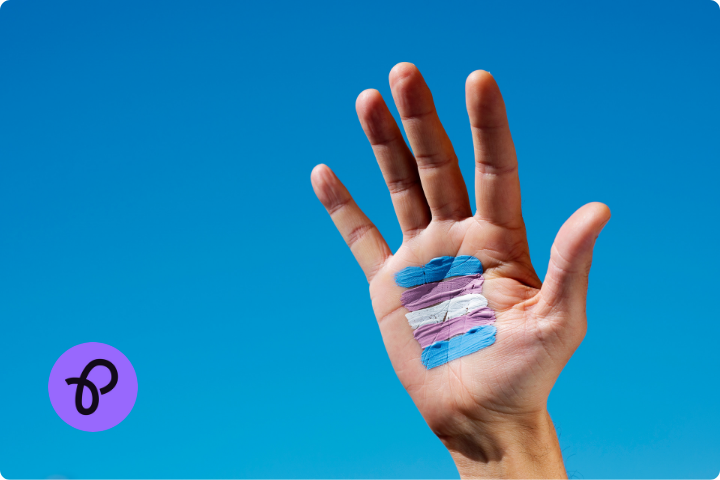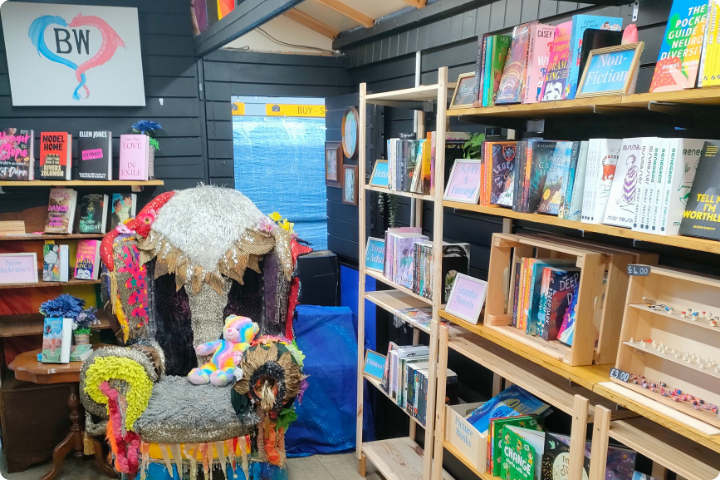All Articles
7 min read
Living at the Intersection: Being Trans, Disabled, and Autistic

Written by
Jason
Published on
March 31, 2025
Today is International Transgender Day of Visibility, and we’re sharing the story of a disabled, autistic trans person whose identity exists at the intersection of many often-overlooked experiences. For them, visibility isn’t just about being seen, it’s about being understood, included, and respected in all their complexity. Their journey highlights the power of embracing every part of who you are, even when the world doesn’t always know how to make space for it.
We celebrate the joy and resilience of trans and non-binary people everywhere by elevating voices and experiences and today we speak to Jason, a Purpl member about his experiences. Many thanks to Jason for sharing.
Understanding My Identity: Transmasculine, Nonbinary, and Autistic
Today is International Transgender Day of Visibility, and I’m honoured to have the chance to speak about my experiences and thoughts as someone who identifies as transgender, and what it’s like being trans and disabled.
My name is Jason, I’m autistic, along with a number of other health conditions, and I identify as a transmasculine nonbinary person. To many people who are unaware, this probably sounds like some long confusing words, but in short – I don’t see myself as a man, woman, or anything really specific.
I go by masculine pronouns like he/him/his, and dress more typically ‘masculine’ generally, but if you asked me ‘what I am?’ I’m just me. If I’m perceived as male by others then that’s fine by me, but internally I don’t see myself as anything specific.

What Does Nonbinary Mean? A Personal and Historical Perspective
The term nonbinary is often perceived as a ‘new fad’ type of thing, but the term has been used since the 1990’s, and many countries over many years have had concepts of gender outside of the field of just ‘male’ and ‘female’. Generally the nonbinary identity is pretty unique for each person, with some people simply not identifying with any form of gender label, and others perhaps feeling in the middle some days, and closer to others another day.
It’s essentially an umbrella for, well, not being on the binary of gender. I do feel that on transgender day of visibility, it’s important we do support those in the trans community who may at times be overlooked – those who are both trans and disabled, or those who do identify not just as a man or woman.
Unfortunately in today’s social climate it grows harder for both trans and disabled people to stay safe both socially and in general, so the more we can band together and create understanding and safe communities the better!
You can find a lot of information about what it means to be non-binary on the LGBT Foundation website here.
“Is It Just the Autism?” – Debunking Harmful Myths
Growing up as both disabled and transgender, it was difficult. A lot of questions were aimed at whether my gender identity was just ‘down to the autism’, with assumptions being thrown that it was just a special interest and a passing obsession. I first came out as a transgender man, transitioning from female to male, when I was around 12. I’d hit puberty and suddenly it went from everyone just being a person to everyone being ‘man or woman’, and I just didn’t get it.
I never fit in with the girls, I never felt like a girl. It was distressing – until I happened to see a youtube video by a trans man. The sigh of relief in realising that I could actually be who I felt I was inside, was amazing!
My parents were cautious but supportive, took time to research and got me help through the NHS. But even then, there were the persistent questions of whether or not my autism was a drive for my identity. Almost an assumption that I couldn’t really decide these things due to my disability, which was more insulting than anything else – not that I don’t understand why they had to question these things.
Now that I’m older, I do think that my autism influences my gender identity to some degree. For a long time I went with the male identity as that’s what seemed to fit best to how I felt, and I did fear exploring anything outside of that due to the already difficult views from society on transgender people.
But I never really did feel quite man or woman, or really anything? In my mind I’m just me, nothing specific, just myself. Some days I wear more typically ‘feminine’ clothing, others it’s typically ‘masculine’. Sometimes I like makeup, others I can’t be bothered to shave and end up with stubble.I do think my autism influences my view of gender, as I’ve never quite understood it fully, but in a way I think it helps me understand different identities more. Since to me, a body is a body, nothing more than that.

How Puberty Blockers and Testosterone Saved My Life
I do also want to note, as part of this, as it’s something often misunderstood and flooded with misinformation. I received hormone blockers as a child, around 2 years after I came out, and then testosterone which I still take, once I was 16. Unlike what many people assume or say – I have zero health issues due to these, and without them I wouldn’t be here! The ability to safely ‘pause’ my puberty for a while was life saving, without it my mental health would have severely worsened and I am forever grateful that I was able to access this medication as a child.
At the end of the day, gender is a weird, complex thing. As long as someone is happy – their identity does not harm anyone else. I hope that on this transgender day of visibility, anyone that may be happening to read this and is unsure or wary of trans people, could take the time to consider my words. Consider researching and speaking to trans people themselves, from an unbiased point of view.
The world has become a harsher place for us, when all we want to do is express ourselves safely and live happily. It’s draining and upsetting seeing so many news articles and ‘influencers’ speak on our community and individual identities with nothing but negative intentions, and no real understanding or research. Especially when many of us are already living with our own stresses, worries, etc. Please be kind to your local trans person, we just want to be ourselves the same way anyone else does.
Trans and Disabled People: The Statistics
Stonewall explain that the 2021 Census was a historic moment for the LGBTQIA+ community in England and Wales as the Census included two new voluntary questions on sexual orientation and trans status.
The results showed that 0.5% of the population reported having a gender identity that is different from the one they were assigned at birth.
The number of trans women and trans men is almost exactly the same – each accounting for 0.1% of the population (48,000 people in England and Wales) and 0.06% (30,000 people in England and Wales) identifying as non-binary.
Studies show that transgender adults have higher rates of disability than cisgender people and this continues into the whole of the LGBTQIA+ community, with studies showing that LGBTQIA+ people are more likely to be disabled than non-LGBTQ+ people.
Evidence suggests that neurodivergent individuals, particularly those diagnosed with autism, are significantly more likely to identify as LGBTQIA+ than those who are neurotypical.

However, a recent Cambridge University study found autistic people might be three times more likely to identify as trans, while another study found neurodivergent individuals were 8 times as likely to be asexual.
John Anderson is The Brain Charity’s LGBTQ+ representative and states:
No one is really sure why there is such an overlap between the neurodivergent and queer communities, but the predominant theory is that neurodivergent people tend to be less aware of or inclined to follow societal norms.
We live in a binary society where being heterosexual and cisgender is the default, so neurodivergent people may feel freer to express their gender or sexuality without the worry of being judged, or the need to conform to society’s expectations.
Bookwyrm Durham LGBT and Disabled led Bookstore
Bookwyrm Durham is an LGBT & disabled ran bookstore local to me, I’m friends with the owners and they often do work for charities and supporting LGBTQIA+ and disabled communities, the owners are absolutely lovely and I definitely think they deserve more support for how much work they do!
BookWyrm is an indie bookshop found in Durham’s Indoor Market Hall. Owned by husband/husband duo Chris & Miles, they specialise in LGBTQ+ books as well as books by small authors and independent presses. You can find them on facebook at BookWyrmDurham, on instagram and Tiktok!

Support Trans Lives: Charities Making a Difference
If you’re looking to support the transgender community, or if you are looking for support and inforamtion for yourself or a loved one, take a look at some of the incredible organisations working to make the UK a safer, more inclusive place for LGBTQIA+ people.
- Mermaids UK – A charity supporting transgender, nonbinary, and gender-diverse children, young people, and their families. Mermaids provides education, advocacy, and community support across the UK.
- Stonewall – One of the UK’s largest LGBTQ+ rights organisations, Stonewall campaigns for equality and offers resources for education, workplaces, healthcare, and more.
- Switchboard LGBT+ Helpline – A confidential support service for LGBTQ+ people. Whether you’re questioning, need someone to talk to, or want information, Switchboard is there to listen.
- Gendered Intelligence – A trans-led charity focused on increasing understanding of gender diversity. They offer youth groups, training, and creative projects to uplift trans voices and educate wider society.
Are you a Purpl member?
Purpl is the UK’s first disabled discounts site, we are run by disabled people, for disabled people. Our main purpose is to work with brands to get incredible discounts for the disabled community. There are student discounts and Blue Light Discounts, but nothing for disabled people! We don’t think that’s OK!
To join Purpl, you need to be a disabled person living in the UK, we have a variety of different documents we accept to verify your status, it is free to join and with brands such as Morrisons giving you 10% off every shop with them, our members are saving hundreds of pounds a year with Purpl.
Purpl is for everybody, we are a community for all disabled people, we believe we are stronger when we all come together.

Disabled Discounts You Might Like
Morrisons Disabled Discount Codes: 10% off your grocery shopping
MyProtein Disabled Discount Codes: Get an extra 8% off your order at Myprotein
Life Supplies Disabled Discount Codes: Free sample pack (worth £14), just pay P&P
All our Top Offers: Find all our top offers here
Purpl A-Z Brand List: Find hundreds of brands and discounts here
